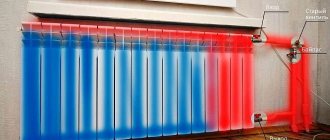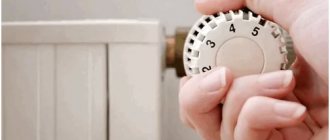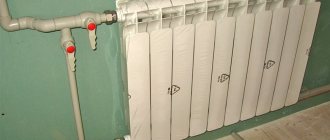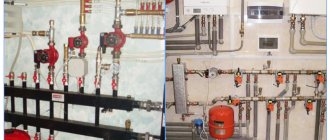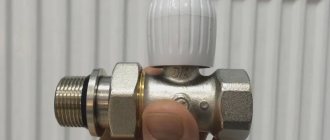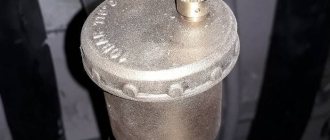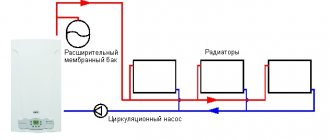Every owner of a private house or apartment with water heating should know how to bleed air from a heating radiator. The thing is that the accumulated air in the radiator becomes an insurmountable obstacle and blocks the flow of coolant.
As a result, the heating radiator ceases to function fully, that is, all or part of its surface ceases to heat up and release heat to the surrounding space.
Airing of the panel heating device (blue color)
To eliminate this phenomenon, you need to bleed the air from the battery. How to do this in a timely and effective manner will be discussed in this article. Carrying out such an operation does not cause any particular difficulties if the heating system is assembled correctly, taking into account all the features of water heating of premises. Throughout the heating season, it is necessary to carry out preventive measures of this nature from time to time.
How to bleed air from a radiator using an air vent
Valves will help bleed air from the radiators (they can be manual or automatic). Let's look at their types.
Mayevsky crane
A needle valve, the design of which includes a body and a cone-shaped screw - very tightly attached to each other, which helps prevent water leakage.
The faucet has a side hole that allows you to bleed air from the coolant using a screwdriver or a wrench from the kit (in some models, manually). When installing the Mayevsky tap, you need to ensure that the tube through which the air is removed looks straight down (but not into the wall!).
Note! For a cast iron radiator, you should choose an automatic air vent.
So, how do you bleed the air out of the radiator? Follow the following instructions:
- Take a wrench or a screwdriver, a rag and place some container under the tap.
- Turn off the pump.
- Begin to carefully turn the tap counterclockwise.
- The air from the radiator is unlikely to be clean.
- Close the tap after water flows from it.
Note! If the system uses low-quality water, then shut-off valves will not be superfluous. First, a valve is installed to prevent debris from accumulating, and then a tap is installed.
Automatic air vent
It helps to automatically bleed air from the coolant if it accumulates. The air vent has a brass body, float, articulated arm and valve. The locking cap is sealed, the spring-loaded protection does not allow debris into the system.
The operating principle of the system is as follows:
- Until it is necessary to bleed air from the radiator, the valve is covered with a float.
- In order to release air from the radiator, the float opens the valve.
- As the gas is removed, the air vent returns to its original position.
Remember! The automatic air vent has a hole for an octagonal wrench or screwdriver, through which, if a problem occurs, the air from the radiator can be vented manually.
Air separator
This device allows you to bleed air from radiators in stand-alone systems. An air separator removes gas accumulated in the system, converting it into bubbles. The device is used in conjunction with a sludge separator, which removes various pollutants from the water.
The system has the following form: a metal cylinder, on it there is an air vent, under it there is a valve for discharging sludge. In the inner part there is a metal mesh that creates vortex flows. Water passing through the system is filled with air bubbles, which rise and exit through the air vent. The remaining dirt is drained through the tap.
Knowing how to bleed air from the radiator will help prevent serious damage. Gas is also removed for “prevention”; this should be done twice (to make sure there is no gas). However, if there are malfunctions in the heating system, then you need to bleed the air from the coolant several times.
Read material on the topic: How to change a heating radiator without errors
Design and operating principle of manual air valve
The needle manual air valve is also called a Mayevsky valve. His device:
- Brass body (plug) with external thread 1/2// or 3/4// for connection to the radiator. The case has two holes for air release Ø 2 mm - one at the end of the case, the second on the side wall;
- Brass locking screw. On one side of the screw there is a groove for a slotted screwdriver, on the other side the screw is machined into a cone that closes the air hole (the “closed” position);
- Plastic casing.
On sale you can find the so-called “faucet at hand”. To use it, you don’t need a key or a screwdriver—the plug can be easily unscrewed by hand.
To remove air from the housing, you need to unscrew the screw. To do this, you can, of course, use a screwdriver, but there are special keys that are most often included. After several revolutions, the screw cone comes out of the end hole and air enters the housing cavity, which is immediately released through the second side hole. The main thing is not to rush to turn off the tap. About 30 - 40% of the air should come out with water, so you need to stock up on time, a basin and rags. After the air has been released, the lost water must be added to the system.
Installation
Modern aluminum or bimetallic heating radiators already have a hole for installing a Mayevsky tap.
It can be found on the side opposite the coolant supply, from above. Most likely, there is already a nut for installation there. There is a plastic plug screwed into it. After its removal, an air valve is installed in this place. Before this, the tap threads must be sealed with a rubber or silicone gasket. Installing a Mayevsky crane on a cast iron battery is much more difficult. Let's start with the fact that these valves are much more powerful than those on aluminum radiators - they can withstand pressures of up to 16 atmospheres and temperatures of 150 C°. Sequencing:
- Drain the water from the radiator;
- Cut a hole in the top plug of the cast iron battery and cut a thread that matches the external thread of the air vent;
- Screw in the Mayevsky tap;
- Add water to the system.
Malfunctions and ways to eliminate them
If the faucet malfunctions, a leak appears. There may be several reasons for this:
- Manufacturing defects. One in fifty taps does not hold pressure at all. The only way out is replacement;
- The screw is too short. In this case, its conical part cannot completely block the hole, so you need to apply a certain force to screw the screw in until it stops;
- Solid particles of debris falling between the screw and the housing can damage the internal threads. Fum tape can help here once, but later you will still have to change the tap.
Prevention
Experts recommend doing prophylaxis once a year. Typically this should happen at the beginning of the heating season. This is the only correct way to reliably avoid breakdowns and unnecessarily high heating costs.
For standardized heat exchangers, also called batteries, you need a small wrench with which you can open and close the vent valve. The diverter valve is located on the opposite side of the thermostat. For a heated towel rail in a bathroom, the valve is at the top (rear).
On the front part in the middle of the valve there is a square pin with which the element rotates. If the pin has a slot, you can also use a screwdriver instead of a square wrench. On the side of the valve is a small nipple or tube with a hole that allows water to flow out when opened.
If you have your own heating system or gas boiler in your apartment, you should turn off the circulation pump and wait one hour to allow any existing oxygen in the radiators to collect at the top. When the pump is turned on, it swirls in the system, reducing the likelihood of complete venting. If you cannot turn off the circulation pump yourself (for example, central heating), close the heating system of your apartment.
Once all heat exchangers have been ventilated, install the circulation pump again. If a lot of water is drained, the pressure in the heating system may decrease. If possible, check the pressure on the system gauge and, if necessary, increase the pressure by adding water.
There are several types of heating systems:
- manual. These devices are small in size and are installed on radiators indoors. It is enough to adjust them with a screwdriver or wrench. Due to low productivity, such air vents are used only for local removal within the apartment;
- automatic. Without outside interference. The devices are very effective, but very sensitive.
Frequent errors and problems during installation
It is necessary to unscrew the screw one to one and a half turns. This is quite enough. If you unscrew the screw too much, it will be difficult to screw it back in under pressure, and quite a bit of water will spill out.
It is advisable to mount the valve in such a position that the hole is directed away from the wall and downwards - the wall will not be splashed when water is released.
When replacing the air vent, when unscrewing it, you must hold the plug with a second adjustable wrench, otherwise it will be unscrewed from the battery.
Bleeding air from heating devices
Before bleeding air from the radiator and from the system, you need to familiarize yourself with the features of this procedure and prepare tools and materials
It is important to understand how to bleed air from a battery correctly. You need to have a special key at your disposal that will help open the air valve on the battery. A radiator wrench is best suited for this type of work - you can buy it at a hardware store
A radiator wrench is best suited for this type of work - you can buy it at a hardware store.
If you have to work with a modern battery, then a simple screwdriver will do. You should also prepare a container for draining the coolant and several rags in case of an unforeseen situation.
Instructions for properly bleeding air from the battery look like this:
First, they inspect the battery and find a small valve (Maevsky tap). It is located at the top of the device; sometimes there are several such devices. Turn off the tap until air hisses.
You must act carefully and smoothly. Place a container under the valve
You should wait until all the accumulated air comes out. This is evidenced by a thin stream of water that has stopped bubbling.
According to some experts, you need to drain approximately 2 - 3 buckets after the coolant begins to drain without gases. This is necessary for reinsurance, so as not to carry out this procedure again. The valve is screwed back on.
In addition to the Mayevsky tap, you can bleed air from the battery using automated air vents. They are intended for heat supply systems and remove plugs independently.
These devices are compact and reliable, but care must be taken, because the valves are unattended and even a slight disruption of the process can lead to flooding of the basement or attic
Sometimes situations arise when, during the installation of the heating system, special products designed to eliminate air pollution were not installed. To release excess air from the device, you need a gas or adjustable wrench to unscrew the plug.
This work needs to be done slowly. If the plug does not unscrew, and such situations most often occur with cast iron radiators, a special lubricant should be applied to the threads. After a while the attempt is repeated. After you have managed to unscrew the plug, proceed in exactly the same way as with a regular tap.
At the end of the work, the plug is returned to its place, not forgetting to wrap flax or FUM tape around the thread, which will prevent leaks and ensure the tightness of the connection.
If air has collected in the heating system of a private house, the coolant is drained using an expansion tank. This container is located at the highest point of the heat supply structure. After draining the water, wait a little, then unscrew the tap on the tank.
As a rule, when the temperature in the battery rises, the plug is removed on its own. If the above actions are unsuccessful, then the water in the heating circuit must be brought to a boil and then the air will certainly escape.
Knowing how to bleed air from the radiator and system, you can avoid many problems. For preventive purposes, a similar procedure should be carried out before the start of the heating season. According to experts, two times (for verification and control) will be enough. If defects or breakdowns are found in the structure, then the number of descents may be greater.
Device
A shut-off valve consists of a body with a hole on the side for air to escape and a conical screw that screws into it.
A fully tightened screw seals the hole in the faucet. The housing has a thread for screwing into a radiator cap or pipe with internal thread. A seal is placed on the housing to seal the connection. Typically, the material used for the faucet is brass. Steel products are practically never found.
What to pay attention to
Each heat exchanger has a release valve, which is usually located in the upper left or upper right corner of the heater. Install the key and turn counterclockwise. You must be slow and careful as there is pressure in the heating system. After a while, a hissing sound may appear. This means that air is being removed from the battery.
Water will start to come out of the heat exchanger, so you must remember to place a container or container underneath it. After a while, only water will come out of the valve. Then it should be turned back clockwise.
Those who have never done this themselves should pay special attention to safety: the water that comes out of the radiator can be very hot at some point. There is even a risk of scalding
Recommendations for selection
The most important recommendation is that you should not buy valves made in China. Almost all models of this origin are of dubious quality. The consequences of such savings can lead to the following:
- In parallel with the air pockets, the device will leak liquid. This leads to a drop in pressure in the circuit, as well as to the appearance of leaks on the body, walls and floor.
- A poor quality air vent may simply not work.
- The coolant quickly renders all structural elements of the valve unusable.
With mechanical devices, this problem occurs much less frequently, since there is practically nothing to break in their design. These products are not some kind of complex equipment, so their cost is quite low. Even well-known manufacturers (for example, Valtec) provide products at an average price. Spirotech machines are also famous for their high quality characteristics. Basic tips for choosing:
- It is better to buy a mechanical valve with a plastic or metal handle. This eliminates the need to fiddle with different wrenches or screwdrivers. It is convenient to use the device even in places where access is difficult.
- If there are small children in the house, then it is advisable to install a regular manual faucet, designed for adjustment with a screwdriver. A child can unscrew the vent with a handle and get scalded by the coolant.
- It is recommended to buy devices with an automatic cut-off.
- 4. If your budget allows, you can purchase a device with additional functions. This makes operating the system more convenient.
- The special anodized coating of the valve plays virtually no role. It only reduces the degree of metal corrosion.
On the market you can find combined designs that are also equipped with a vent. These include balancing valves, various shut-off valves, and circulation pumps. Most experts do not recommend using such products. It is better to purchase each part separately. The ROBOCAL valve is perfect for an ordinary apartment. It is designed for pressures up to 6 bar.
What to do if there is air left
Sometimes after deflating the battery there is no necessary heating. You can fix the problem by blowing or washing the batteries.
You can fix the problem by thoroughly washing the battery.
With an autonomous system, it is necessary to check that it is completely filled. If the coolant is water, then expansion occurs quite quickly. When temperatures drop, water shortages occur.
If there is a need to drain water through the tank, it is necessary to disconnect the home from heating. The valves are pre-opened.
When the temperature rises, the plug comes out. If this does not happen, you need to boil the water. After this, the air will certainly come out.
What and how to bleed air from a heating radiator
In order to control the gas contamination of the system both in an apartment and in a private house, use a manual or automatic air release valve. They should be discussed in more detail.
- Automatic air valve;
- Air separator;
- Mayevsky crane.
The automatic air valve is capable of independently releasing air that has accumulated in the radiator. It consists of a brass body, float, articulated arm and valve. A special cap protects against leakage, and the protection located under the spring protects against the ingress of external contaminants.
The system works on the following principle:
- While there is no air, the float keeps the valve closed;
- As gas accumulates, the float begins to descend and gradually open the valve;
- The accumulation of air leaves the compartments, and the system returns to its original state.
It is important to note the fact that all automatic versions are equipped with connectors that are suitable for a screwdriver or octagonal keys. Thanks to this shape, you can open the valve even in manual mode if the automatic mode suddenly breaks down
As for the air separator, this system is a little more complicated. The principle of its operation is to absorb air, turn it into bubbles and remove it out. Most often, separators are combined with sludge, which is capable of trapping dirt, sand or rust. If we talk about the design, it is presented in the form of a metal cylinder, which includes an air vent at the top and a valve at the bottom, which serves to discharge foreign contaminants. Inside such an installation there is a mesh that creates a vortex flow.
The same method is used when there is a water circuit that is connected to heating. The release in the water supply is carried out as a bleed. That is, a stream of air or water with impurities can be released through the bleeder.
Reasons for airing the system
There are several fairly common reasons that provoke the appearance of an air lock inside heating structures:
- depressurization that occurred during scheduled maintenance or repair work;
- improper flushing or pressure testing of the system followed by filling the water circuit with standard coolant;
- local violation of the integrity of pipelines and radiator batteries under negative external influences or as a result of maintenance and operating errors;
- in private households - the absence of a sufficient pipe slope and expansion tank in the installed system;
- reduced pressure level in the water supply system, filling the resulting voids with air;
- faulty condition of air intake elements;
- connection to the heating structure of a “warm floor” system with pipes of different heights;
- air suction through leaky seam joints and joint areas;
- low quality coolant, oversaturation with gases;
- replenishing the volume of thermal fluid by adding cold tap water.
One of the most common problems is the presence of errors and errors at the stage of creating design documentation or installing pipework.
Bleeding air from heating radiators
Before bleeding air from the radiator and from the system, you need to familiarize yourself with the features of this procedure and prepare tools and materials
It is important to understand how to bleed air from a battery correctly. You need to have a special key at your disposal that will help open the air valve on the battery
A radiator wrench is best suited for this type of work - you can buy it at a hardware store.
If you have to work with a modern battery, then a simple screwdriver will do. You should also prepare a container for draining the coolant and several rags in case of an unforeseen situation.
Instructions for properly bleeding the battery:
First, they inspect the battery and find a small valve (Maevsky tap). It is located at the top of the device; sometimes there are several such devices. Turn off the tap until air hisses.
You must act carefully and smoothly. Place a container under the valve. You should wait until all the accumulated air comes out. This is evidenced by a thin stream of water that has stopped bubbling.
According to some experts, you need to drain approximately 2 - 3 buckets after the coolant begins to drain without gases. This is necessary for reinsurance, so as not to carry out this procedure again. The valve is screwed back on.
In addition to the Mayevsky tap, you can bleed air from the battery using automated air vents. They are intended for heat supply systems and remove plugs independently.
These devices are compact and reliable, but care must be taken, because the valves are unattended, and even a slight disruption of the process can lead to flooding of the basement or attic.
Sometimes situations arise when, during the installation of the heating system, special products designed to eliminate air pollution were not installed. To release excess air from the device, you need a gas or adjustable wrench to unscrew the plug.
This work needs to be done slowly. If the plug does not unscrew, and such situations most often occur with cast iron radiators, a special lubricant should be applied to the threads. After a while the attempt is repeated. After you have managed to unscrew the plug, proceed in exactly the same way as with a regular tap.
At the end of the work, the plug is returned to its place, not forgetting to wrap flax or FUM tape around the thread, which will prevent leaks and ensure the tightness of the connection.
If air has collected in the heating system of a private house, the coolant is drained using an expansion tank. This container is located at the highest point of the heat supply structure. After draining the water, you should wait a little, then unscrew the tap on the tank.
As a rule, when the temperature in the battery rises, the air lock is removed on its own. If the above actions are unsuccessful, then the water in the heating circuit must be brought to a boil and then the air will certainly escape.
Knowing how to bleed air from the radiator and system, you can avoid many problems. For preventive purposes, a similar procedure should be carried out before the start of the heating season. According to experts, two times (for verification and control) will be enough. If defects or breakdowns are found in the structure, then the number of descents may be greater.
Cast iron batteries
The Mayevsky crane simplifies the work, but not all batteries have such a convenient device. For example, on cast iron versions you can often find a regular plug screwed onto tow and coated with paint. Removing it is problematic. Of course, you can visit the neighbors below or above, who have a Mayevsky tap on the radiator - this way you can gain access to the coolant. But this is not always possible.
We'll have to resort to the "old-fashioned" method. You will need a basin, a bucket and a lot of unnecessary rags. You don’t even have to try to unscrew the plug with your bare hands; you need to take an adjustable wrench. A paint thinner will also come in handy; the plug must have dried firmly over a long period of time. Then follow the instructions:
- Apply solvent to the plug and wait twenty minutes.
- Run along the thread with an adjustable wrench until the plug gives way. You should hear the sound of air escaping.
- When the sound dies down, you need to wrap a new layer of “fumka” around the plug and insert it in its original place. If necessary, touch up the joint.
In order not to worry about heating the room in winter, you just need to promptly remove air pockets that interfere with the normal movement of the coolant. The result will be a warm, cozy atmosphere in the house even in the most severe frosts.
Correct option
To carry out a successful operation, an adjustable wrench is a must, as well as a basin and rags. You will need to purchase tow, FUM tape or sealant. It is imperative to shut off the coolant supply. The following steps are performed sequentially:
- First, remove the tow, but first place a container under the radiator. If you can’t get to the tow right away, then remove (dissolve) the paint.
- Carefully, slowly unscrew the plug. Any sudden movements or great efforts are avoided, because there is always a risk of breaking the thread.
- If the element does not lend itself, then use a solvent or WD-40, a rust converter. The product is poured into the problem joint.
- Then they pause: wait 5-10 minutes. Then they repeat the steps, also carefully. The operation is stopped when an extraneous sound appears.
- After unscrewing the plug, the air masses begin to gradually bleed off, this process is always accompanied by hissing.
- At the end of this stage, approximately 3-5 liters of water are drained. These actions will minimize the chance of encountering a traffic jam again.
Then the plug is screwed tightly again, having previously wound a new portion of tow. It can be replaced with more modern products - FUM tape. However, they believe that the best option is a combination of these materials. But the shrinking tape has a competitor: they often prefer to coat tow with sealant rather than wrap it with fumigation. For example, UNIPAK sealing paste.
After these manipulations, open the coolant supply valve. Since this method is very complicated, if you lack the skills, it is better to call a specialist, since a leak can be very expensive for the owners. Any master plumber, on the contrary, is well aware of how to bleed air from a battery.
Unsafe express method
If the radiator has been standing since “antediluvian” times, then it is quite possible that the owner will not be able to cope with unscrewing the plug on his own. In this case, some recommend an original method - drilling a hole in it.
To do this you will need a drill, a screwdriver and a metal drill (maximum diameter 4 mm). You also need to find a self-tapping screw; its diameter should be 1.5-2 mm larger than the hole. You will need a rubber gasket under it. To ensure the reliability of the “hot spot”, it is recommended to use a sealant.
The work itself is simple, but must be done quickly.
- First, drill a hole, then carefully and slowly pull out the drill.
- After this, the air will come out and water will begin to flow, quickly screw in the self-tapping screw with the gasket on it.
They say that pre-coating this structure with sealant guarantees almost one hundred percent reliability of the system. If the owner has a desire to test this “maximum”, then he is a person who is not afraid of possible consequences.
How can you avoid the formation of an air lock?
How can you remove air?
The ideal option is when, during installation of the heating system, a special Mayevsky valve is built into each radiator, with which you can bleed air from each radiator separately.
You can also use an automatic air vent, which will autonomously control the entire heating system. Even with a perfectly functioning heating system, you will still have to periodically bleed the air from the batteries, but this will not cause much difficulty.
While filling the system, try to control the water pressure and temperature of the radiators. If suddenly the water pressure begins to drop sharply, it means that the seal of the battery has been broken somewhere. If the temperature of the batteries is not stable, look for an air lock in the heating system.
If your batteries are equipped with automatic air vents, then you can rest easy: they will do all the necessary work for you to eliminate air from the radiators. If the batteries are equipped with small manual taps, then you need to carry out the entire procedure for removing air from the heating radiator yourself.
Another important point is the pipeline itself. Quite often, an air lock can form in very difficult places in the pipeline, where there are many bends, turns or incorrect slopes. In such areas it is necessary to install additional air vents.
How to bleed air from a battery?
In order to remove air from the battery, you need to use a special Mayevsky tap, which is designed specifically for this.
Prepare a bucket for water in advance. In the upper right corner of the radiator you will find the Mayevsky tap, which must be unscrewed with a special key or a regular screwdriver. Don't forget to place a container where the water will drain.
Listen to the sounds that the battery makes: first you will hear a slight hissing sound, which indicates that there is indeed air in the battery, which means that you are doing everything correctly. Now water should drip from the battery, wait until the water runs in a thin stream and screw the tap into place.
There are times when eliminating the air lock in the batteries did not bring any results, and the radiators still remain cold, then it is necessary to thoroughly rinse and blow out the battery.
If this procedure does not yield anything, you need to look for the problem in the heating system itself.
We hope that the material was useful to you. If it’s not too much trouble, please click the social media buttons so that others can read this article.
Have a nice day!
In a private house
Many houses have radiators with a Mayevsky tap, so when airing the system, you can use the same method as in an apartment building.
However, usually such devices are not available, which is why the only way is to drain through the expansion tank. Such a device is a mandatory element of any heating system in the house. It can be open or closed. The first option is easier to operate, and airing the system usually means lowering the water level in the tank. To eliminate the problem, it is enough to replenish the missing amount of fluid.
If the heating system has a closed tank, the only solution to the problem is to bleed air through the radiators. Before doing this, it is recommended to try to completely fill the system so that at least 10 liters of water flow out of the control pipe leaving the tank.
After this, you need to start the system again. If the problem persists, it is recommended to bleed air from the battery, following general recommendations. It is worth noting that in old-style heating systems, air may appear in the radiators during intensive operation of the heating boiler.
This is especially often observed when installing solid fuel models without a built-in thermostat. The water heats up excessively, begins to boil and pours out through the control pipe of the expansion tank. As a result, it becomes empty and, if there are cracks that break the tightness, air masses begin to enter the system. Then you can bleed the air using any of the listed methods, but before doing this, you need to eliminate the holes or cracks. Otherwise, the descent will have to be repeated regularly.
Application of the Mayevsky crane
Air can be released using special removable handles. They are put on the inside of the valve, which is made of metal. If such a handle is missing, it must be replaced with a notch for a screwdriver.
Mayevsky crane - a convenient device
How to properly remove air from a heating system?
- Place a container under the tap (volume – 500-1000 ml).
- Open the tap. Wait until the air comes out. Then a characteristic hiss will appear, indicating the flow of air mixed with water.
- Wait until clean water comes out.
- Close the tap.
If there is no handle, you will need to use a screwdriver or wrench. You can use a gas or adjustable wrench
If the tap is screwed on very tightly, you need to act carefully. Otherwise, you can rip it off, the consequences of which can be catastrophic.
The instructions are:
- Wrap the surface of the radiator. Use a rag or rags. Place a container to allow liquid to drain out.
- Turn off the tap and wait for the hiss to appear.
- Wait for the water to drain out.
- Drain the water (up to 2000 ml).
- Turn on the tap.
- Wait 10-12 minutes.
- Turn off the tap and make sure that the air comes out completely.
- If this does not happen, you need to repeat the procedure.
Plug on the battery
If the tap is missing, and instead there is a Soviet-style plug, you need to proceed as follows:
- Wrap the desired area with thick fabric. You can use rags. This will eliminate the risk of high pressure.
- “Arm yourself” with a converter (can be replaced with a solvent).
- Carefully turn the plug. There is no need to take it out completely, otherwise there will be a “flood” in the apartment.
- Wait for the air masses to come out. The flow can be felt by placing your hand near the plug.
- Wait until the water flows out (3000-5000 ml).
- “Arm yourself” with fum tape and wrap the plug. The required direction is against the thread. This provides the necessary tightness.
- Screw the plug as tightly as possible.
For individual heating, you can use an expansion tank.
If you have individual heating at home, you can get rid of the problem using an expansion tank. They can be open or closed.
In the first case, we may be talking about a decrease in the coolant or water level. They should be added to the system. It is advisable to use the bottom valve. The radiator can be absolutely anything. If this is not possible, you will need to use a tank.
After removing the air lock, it is necessary to start the system. She should do a good job. If the plug remains, it is drained using the radiator.
If the type of tank is closed, then you first need to check its functionality.
Safety precautions and preventive maintenance
To avoid injuries and other problems, you need to follow a number of rules when bleeding air:
- The rod from the air valve cannot be unscrewed - the pressure of the heated coolant will not allow it to be screwed back on;
- The body of the tap also cannot be turned out - it is very easy to break the thread, but it is difficult to eliminate the consequences of flooding the apartment;
- The radiator caps cannot be unscrewed even partially - they cannot be returned later, and boiling water pouring out of the radiators will bring a lot of negative emotions (about

